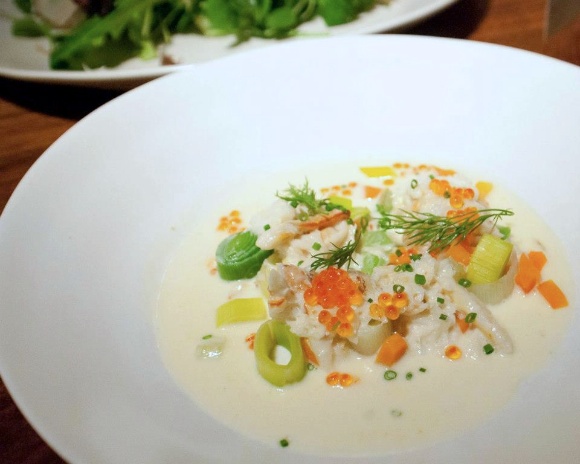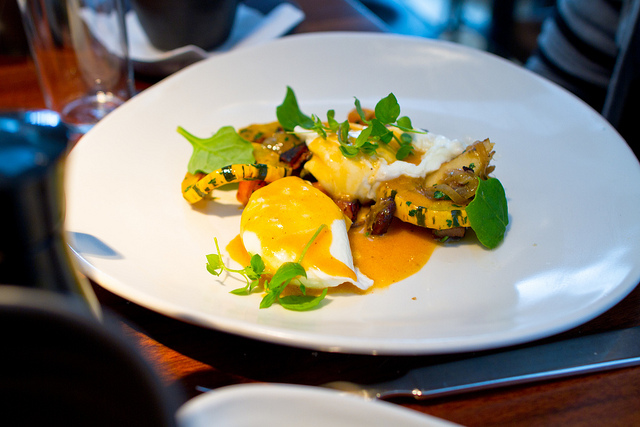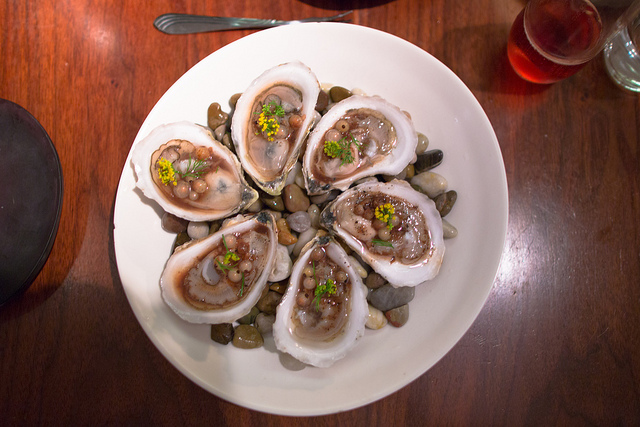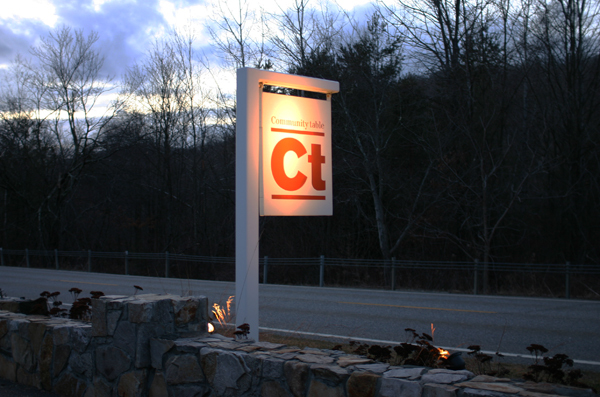Community Table in Washington CT

In the Litchfield County town of Washington, the two-year old Community Table and its team led by Executive Chef Joel Viehland, stands at the center of a tight network of farmers, foragers and discerning diners. Born from agrarian collaboration rather than co-opting it, Community Table was built around the notion that a restaurant serving its community must not only serves its diners, but act with respectful stewardship of the land. This translates to sourcing seasonally, locally and sustainably, as well as pickling, drying, fermenting and composting.
Community Table’s logo is a sly nod to its geographical home. The orange letters “CT” painted on white sign standing along a quiet strip of Route 202 road, quietly signalling the restaurant’s entrance. Inside is a pair of intimate rooms where art and object reinforce the restaurant’s agrarian ethos, from a stag head trophy mount in mesh orange, to faux fur animal hides draped across Shaker-inspired chairs. Fittingly, a community table made from 300 year old black walnut anchors one of the dining spaces underneath a dramatic lofted ceiling.

Brunch at Community Table. Photo: Amy Kundrat
Community Table’s menu changes weekly, with subtle daily changes to the menu’s usual six appetizers and six entrees that are equally balanced around locally sourced proteins and vegetables. Flip over the daily menu, and you will find an exhaustive list of farms and foragers that supply the menu, a glimmer into the restaurant’s approach and their network of suppliers. In between first and second courses and this list, stands a selection of local artisanal cheeses, Connecticut wines, and inventive desserts by pastry chef April Massey to complete the experience.

A warm crab appetizer with leeks, sea trout roe and fresh cream. Photo: Elizabeth Dorny“Farm lettuces” often kick-off a list of six appetizers. Community Table’s definition of this salad is constantly shifting. On a recent wintry visit, these lettuces were populated with pickled vegetables and a few heartier, starchier root vegetables such as crispy parsnips. During the summer, nasturtiums, colorful flowers and foraged greens are more populous. A few appetizers boast seafood, with a warm crab with leeks, sea trout roe and fresh cream a recent stand-out.

Photo: www.Spanishhipster.comUnassuming on the menu, a whole roasted carrot is anything but, when plated. This dish typifies the Community Table experience. Sourced and recently picked from a nearby farm that day, the carrot is cooked to perfection with a pleasant hint of crispness on the outside, giving way to a smoother and buttery interior, with warmth imparted by buttermilk and pistachio oil . A dusting of pine and duck fat powder, and a thin sheath of lardo (brought back from the chef’s recent trip to Tuscany) complete the carrots transformation from vegetable to a complete and winning appetizer.

Winter duck breast entrée with braised red cabbage, beets, blueberries, and radicchio. Photo: Elizabeth DorneyEntrees are equally weighted between proteins such as lamb, fowl, seafood, game, and pork, as well as a vegetable-based entree. On most of my five or so visits, organic duck has always been among the entrees. Recently this dish was a stand-out in its preparation and presentation, a medium rare organic duck breast plated among a shockingly rich spectrum of ruby red hues including braised red cabbage, beets, blueberries, and radicchio -- elements further unified both in flavor and presentation by a port duck jus finish.
Game also tends to be a signature Community Table offering. On an early winter visit, a venison tartare with a tarragon cream shocked and awed. Recently, an elk entree was offered with root vegetables, chestnuts and a red wine elk reduction. I often overlook the vegetarian entree on the menu in favor of fish or game, in part because I know the protein is thoughtfully sourced and difficult if not impossible to duplicate in my own kitchen.

Photo: www.Spanishhipster.comOn a recent visit, I ignored a Skate Wing, a Red Fish Hot Pot and that tempting Elk, and headed straight for the Mixed Grains. In this dish, quinoa and cous cous sat atop an interlocking mass of squash, including spaghetti and kabocha, with small roasted potatoes and turnips aloft bright green beet greens and kale, accompanied by a subtle potato broth that cooked the vegetables and possibly the grains. When your central focus is vegetable or grain-based, you are forced to marry and draw out their much more subtle flavors and build and layer them accordingly. As a result and to my surprise, this vegetarian preference was rewarded with a subtle complexity that most protein can’t offer.

A Community Table summer salad. Photo: Amy KundratDesserts continue to rise to the occassion on recent visits. An eggnog croquemboche was a surprisingly subtle embrace of that rich creamy and subtly spiced holiday drink. Its profiteroles were textbook, with a drizzle of caramel. Listed on the menu by ingredients, the "walnuts, raspberries, walnut ice cream and milk shards," was an unexpected deconstruction of powderized components enveloping the velvety ice cream.

Walnuts, raspberries, walnut ice cream, milk shards. Photo: Elizabeth Dorney.This series of impressions are a way of affirming something Chef Viehland told me several months ago as we chatted about the restaurant’s culinary roots: “I want my diners to feel better when they leave then when they came in,” was a statement that stuck with me and particularly resonated on this last visit. I left, as I often do, particularly sated and overwhelmed by perceptive and creative flavors, not bulk.
Chef Viehland studied cooking at Johnson and Wales Culinary School before moving to New York City to work at Gramercy Tavern and with Chef Katy Spark at Quilty’s. From New York, Viehland moved to New Orleans, where he spent ten years making his way through its best kitchens from Herbsaint to Emeril’s and finally, Stella. Trading Louisiana spice for Nordic minimalism, Viehland moved to Copenhagen to work at NOMA, which introduced him to foraging as a new definition of local and seasonal cooking. The culmination of these experiences married with the agriculturally rich area of Washington, begins to explain the nascence of Connecticut’s most radically local menu.

In the summer, I have been drawn to Community Table by its quiet location, an unusually elegant pit stop for a Sunday motorcycle ride. In the evenings and throughout the winter, I am drawn back for its inventive dishes and what I consider one of Connecticut’s most bewitching dining spaces in its colonial modernity. This deference to seasonality and design explains why it continues to be that restaurant I always escort my out-of-town guests--from San Francisco to Bavaria-- because I know they will appreciate its attention to detail and inventiveness, and its embrace of nature and strikingly local food.

























